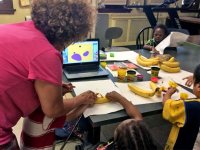Hands-On Apps for Diverse Learners
Diverse learners demonstrate engagement and creativity when introduced to the game jam model of exploration.
Using games to teach can increase student engagement and add meaning to learning. Hands-on apps give children the ability to mix tactile play with a digital experience. Thanks to augmented reality, more and more apps in the market blur the line between digital and analog. For example, Bloxels uses color-coded blocks that can be scanned in with an iPad camera to create a video game level. Osmo is another digital/analog blend. The kit includes a stand and a reflector for an iPad camera, enabling users to play with physical tangram puzzles or word games.
Hands-On Game Jam
This summer, I organized a hands-on game jam day at the A. Harry Moore School at New Jersey City University, which serves students ages 3 to 21 who have low-incidence disabilities. Many of the students are in wheelchairs.
For the opening whole-group session, I showed a BrainPop video about video games. Next, everyone was given a hands-on task: to explore the playability of objects. Each table had an assortment of plastic cups, ping-pong balls, string, tape, and other items. The goal was to make a simple game out of everyday objects. A cup would no longer serve its intended purpose for drinking water. Instead, it became a basketball hoop, a phone (attached to a string), or a hat. This theme recurred throughout the day. Tactile and kinesthetic learning would be paired with game-like activities.
Teachers next hosted 30-minute breakout sessions in different classrooms, taking care to ensure that students were as active as possible in playing, creating, and designing.
One room featured Compose Yourself, a game designed by music composer Philip Sheppard. As with many good games, Compose Yourself emphasizes play first. After all, writing music is hard. To play, choose cards from the set. Each is transparent and adorned with a measure of music notes. They can be flipped around or turned over. Enter one of the four accompanying codes on each card into a computer browser and listen to a world-class orchestra play the melody back. Students can download and share their compositions. They can also print out their songs. This enables children to play with musical compositions. This video shows you how to play Compose Yourself.
Playing With Tech
Constructasaurus, playable for free on BrainPop Jr.’s GameUp page, was next. Developed by the Children’s Museum of Indianapolis, it gives students the opportunity to build a dinosaur. Once built, the dinosaur is tested—too top heavy and it might tip over, for example. This game activity worked well on an interactive whiteboard.
Another classroom remixed the party game HedBanz. The facilitating teacher adapted the reverse-charades guessing game to also include objects, and students were given blank index cards to make their own variations. Teacher-facilitated modifications helped achieve the goal of keeping everyone engaged in a playful experience.
The gym featured Sphero, the robotic iPad-controlled ball. Students were given the chance to maneuver it though an obstacle course. Not surprisingly, some children opted to play around with the Sphero, guiding it outside of the planned obstacles. Keeping with the spirit of play and fun, this was encouraged.
I ran a Makey Makey session. The kit essentially hacks a computer’s keyboard to a tiny, external device. Attach one end of the color-coded alligator clips to the Makey Makey device and the other end to a low-conductive object, like fruit, Play-Doh, or aluminum foil. Doing so turns everyday objects into computer keys, such as the space bar or the arrow keys.
Using one of the many Makey Makey-themed Scratch projects, I turned bananas into a drum kit. When students walked into the room, they were greeted with me playing the banana cowbell. At first, one of the children remarked that it was “all weird and awkward” to use anything but the keyboard attached to the laptop. After I explained basic circuitry, I handed her some Play-Doh. I then challenged her to make a customized video game controller. As it turned out, the girl who began as a skeptic played a round of Pac-Man using her hacked game controller, remarking, “This was fun!”
Games should serve as a tool for teaching and learning. Don’t let the constraints of rules create a structure that is too rigid. Students require freedom to play within the game’s system. Hands-on, tactile play is an engaging solution to keep game-based learning fun.
